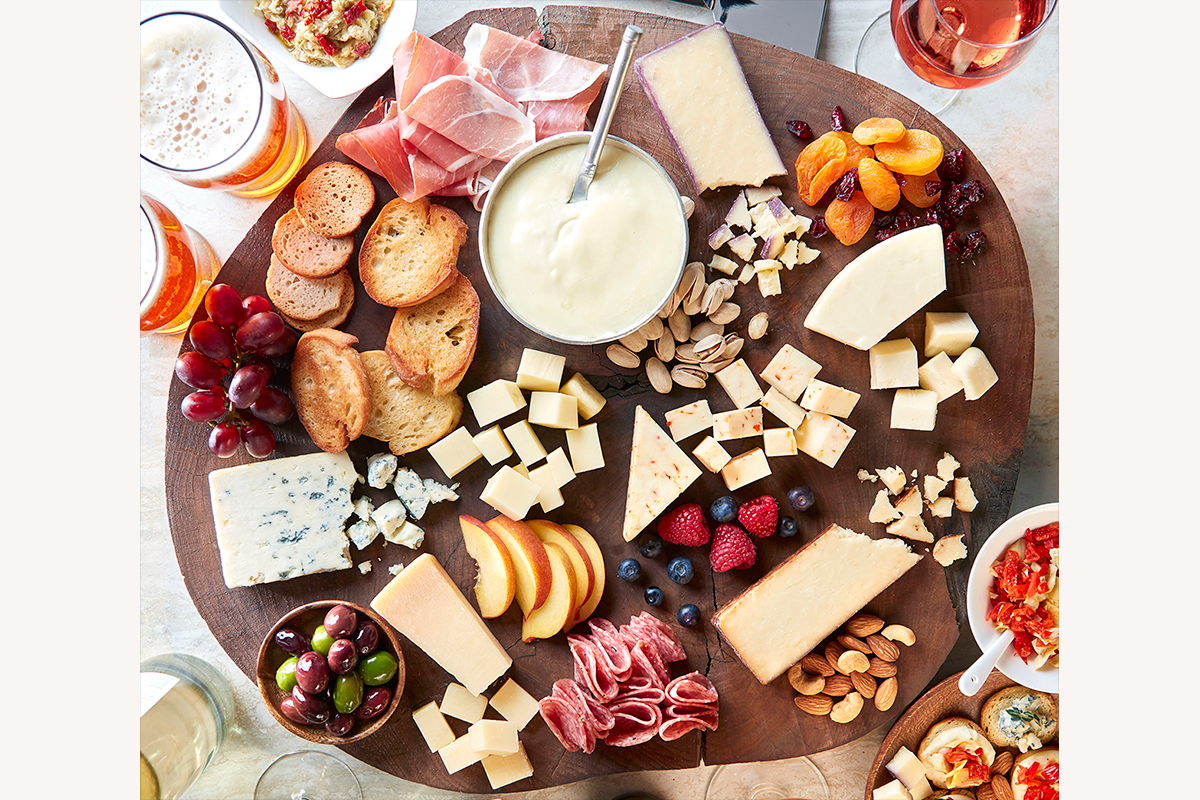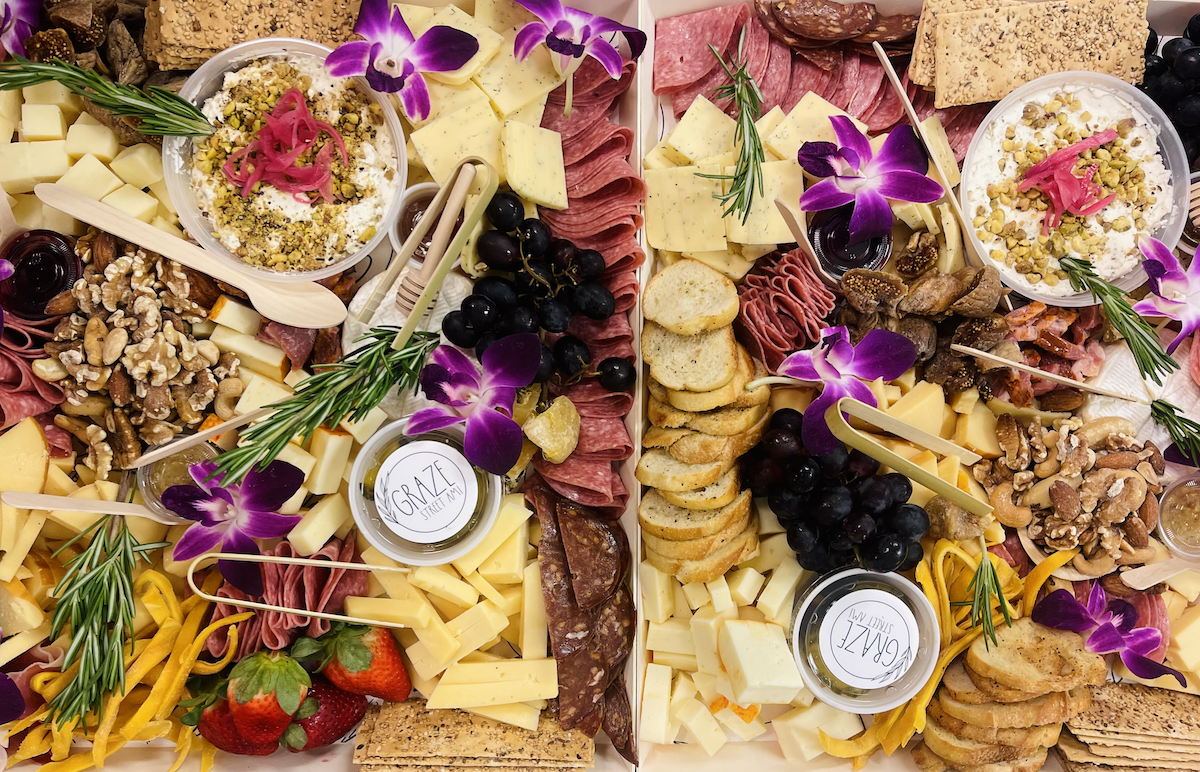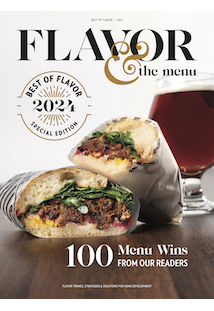
Building a Better Cheese Board
Contrasting cheeses and upgraded accoutrements elevate the experience
Building a Better Cheese Board
Contrasting cheeses and upgraded accoutrements elevate the experience
By Nicole Duncan
June 13, 2024
By Nicole Duncan
June 13, 2024
Few dishes let respective components shine in their original state like the cheese board. Rather than blending, sautéing, baking or applying any number of cooking techniques, these menu items are filled with ingredients that can stand alone, but also tempt guests to choose their own adventure and create different combinations as they nosh.
“The value of a board opens the possibility to try new flavors, build new combinations and do the opposite of what mom said: being able to play with your food,” says Jason Hernandez, chef/founder of Blade & Tine Culinary Consulting. “Boards expand the guest’s perception of what can be created.” A typical board might comprise a few varieties of cheese, bread or crackers, mustard, jam and add-ons like nuts or olives. That said, there is no standard template, which can be appealing to guests and restaurant operators alike. This no-rules approach also helps the bottom line and facilitates back-of-house throughput.
Embracing bold new flavors, adapting to available options and rethinking the accoutrements are all key steps in building a better cheese board, season after season and year after year.
Choose Your Cheeses Wisely
Obvious as it may be, cheese is at the heart of a cheese board—as well as many a charcuterie board, too—and, accordingly, demands special care in its curation and selection.
“The cheese needs to be the star, so being careful to not overwhelm the board with accoutrements is key here. The goal is to make it simple; take a picture and hang it in the kitchen so the staff can just follow the pattern,” says John Franke, chef and president of Franke Culinary Consulting. To anchor the board, he selects a cheese to represent three different textures: soft, medium-soft and hard.
For soft cheeses, Franke suggests logs of goat cheese, a jar of labneh, dollops of burrata or a spread of ricotta marinated in a basil pesto. Because these cheeses have milder, more neutral flavor profiles, the chef will add fresh herbs, peppers, peppercorn and even marinades to punch up the taste. For a slightly firmer but still soft cheese, go-tos include mozzarella, blue cheese or Gorgonzola, smoked Gouda or, for larger parties, a warm wheel of Brie. While medium-soft cheeses like Gorgonzola and smoked Gouda bring stronger, more pungent notes, it’s the hard cheeses that really drive home savory, umami-rich flavors. Franke recommends a very sharp cheddar, pecorino or Reggiano, manchego, or Gruyère or Comté.
To balance costs, he likes to source a couple cheeses from broadliners and then spotlight a niche variety since they can be two to three times more expensive. “You can showcase a more artisanal cheese and control the portion to ensure you are keeping the board new and exciting, while still maintaining a good price point,” Franke says. “Generally, hard cheese is where I’d land with a local artisanal variety.”
Hernandez, who also operates the chef-driven market/restaurant Graze Street AMI in Anna Maria Island, Fla., will move cheeses on and off the menu on a regular basis. Like Franke, he tries to showcase a variety of flavors and textures in each assortment, though a few perennial favorites crop up: sharp aged white cheddar, something smoky like Gouda or smoked mozzarella, and a creamy variety like Brie or chèvre. For extra panache, he’ll sprinkle in seared halloumi, aged blues and heat-infused varieties like habanero cheddar.
Throughout it all, Hernandez keeps the consumer at the forefront of the curation process. The restaurant, its regular clientele and average price point all come into play. “Have an understanding of who the guests are and what they are looking for when coming into your establishment,” he advises. “For the more adventurous brands, there are no rules—these guests are willing to try new flavor combinations, exotic meats and cheeses and accoutrements.”
That’s not to say restaurants should restrict themselves and their customers to the familiar, but rather make sure certain touchstones appear on the cheese board and use those items as a springboard to introduce new, unexpected varieties. “Understand the guests’ expectations and then start to push the limits. Guests now are more than ever willing to try new flavors and experiences,” Hernandez says.
Add Panache to Supporting Players
Like other starters, as well as side dishes, small plates and desserts, cheese boards provide a less intimidating path to sampling new ingredients and cuisines. “I love getting to slip more trend-forward, obscure ingredients into items that allow the guests to experiment without overcommitting to a full dish,” Franke says. While these trend-forward options might include less-common varieties of cheese, they also pertain to the accompanying ingredients.
Operators needn’t go full-tilt but can begin with subtle tweaks. Franke offers on-trend African spices and pastes as simple additions to the typical mustard and preserves. Asian-inspired twists, such as gochujang-infused cherry jam, also bring global intrigue and sweet heat. “A cheese board is a great place to tuck in some kimchi as well,” he adds.
Whether kimchi, cornichons or danmuji, freshly pickled veggies and fruit bring forth a burst of tangy, sour notes. “The boards need something briny and tart, so we will make traditional pickles, then expand into more global flavors,” Hernandez says. “We will pickle mango, avocado, watermelon rinds and all sorts of seasonal veggies.” Graze Street AMI sources local honey and also makes its own jams based on what’s available. “We are constantly changing the flavors of all the condiments to go in line with the season, and, really, we like to play with food,” he adds.
Frequent guests appreciate how the boards change with the season, and the restaurants are grateful for the flexibility such a strategy proffers. “The value is tremendous. From a cost standpoint, you can adjust what is on the board depending on the market price for various cheeses, breads, condiments, honey and produce. You can also adjust it per the season—peaches and strawberries in the summer, and cherries and stone fruit in the fall,” Franke says. He also tries to incorporate a complementary ingredient into the fruit spread or preserves, such as peach-pecan, strawberry-basil, blackberry-serrano, rhubarb-thyme or blueberry-sage.
Franke recommends putting similar spins on the other condiments. Try brightening mixed marinated olives with citrus zest, toasted fennel and garlic cloves. Infuse honey with lavender or ancho chiles—or serve a honeycomb in place of the syrupy liquid. Play with sweet and salty nut treatments, like candied cashews or spiced pecans. “This sounds like a lot of items, but the idea is a small amount of each or a combination of each,” he says.
When it comes to meat on a cheese board, Franke isn’t sold on it from a menuing standpoint. “If it’s a true cheese board, then it really should be a variety of cheeses with no meats,” he says, explaining that otherwise it would fall into the category of meat-and-cheese or charcuterie board. If meats are included in a cheese board, they shouldn’t overshadow the dish’s headliner.
Bread and/or crackers, the final component of a cheese board, are neutral carriers that can balance the bold flavors of the other ingredients. Nevertheless, Hernandez considers this component to be a high-impact player on the board. “Utilizing a variety of crackers will help with the aesthetics. Traditional, gluten-free, seeded and others all support the board. Housemade breads or crostini are a great addition, too,” he says.
 Photo Credit: Graze Street AMI
Photo Credit: Graze Street AMI Jason Hernandez’s market/restaurant Graze Street AMI regularly mixes up its cheese boards, but fresh ingredients and elevated presentation are always the rule of thumb.
Build It to Stay—or Go
From an operational standpoint, cheese boards are among the easiest menu items to execute. “A cheese board is more ‘paint by numbers’ in the kitchen. Labor-wise, you can have any entry-level cook assemble them and they are a very quick pick up,” Franke says. He adds that it can be a good idea to let staff play around with different ingredients and presentations during non-service hours, as it’s a team-building activity and educational opportunity. But for the sake of consistency, the team should follow a uniform example when it’s time to serve guests.
At this point, guests take the reins in the curation process, though certain tableside flourishes enhance the dine-in experience. “Cheese boards can become more experiential if you do things like melted raclette at the table,” Franke says. “The fact that guests have to ‘build their own bite’ with a touch of mustard/jam, a smear of honey, a chunk of cheese, and a toasted bread/lavash means each bite—and each visit—makes for a different flavor experience.”
For larger restaurant brands with multiple locations, Franke recommends doubling down on customization. Provide guests with broad strokes on different styles of cheeses, jams, mustards, nuts and other accoutrements, and then invite them to build their own board from a dozen or so different options. Those operators might also have the resources to invest in specialized to-go containers for off-premises orders, which Franke likes to refer to as “Adult Lunchables.”
For Hernandez, presentation is paramount, whether guests are dining in the restaurant or at home. That means all fruits and vegetables are fresh and look fresh, too. Cheeses and meats may be cured, but they should never be dry. “Create boards that are colorful and delicious,” he advises. “For off-premises, the big focus is to make sure it looks like the picture. The guests are putting faith in you to create something great based off what they see.” This approach holds true regardless of what ingredients comprise the whole. At Graze Street AMI, the selection has included the Grazing Board (a more traditional mix of cheese and meat), the Savory Board (with a greater emphasis on meat and hearty sides) and a Brunch Board, which showcases both sweet and savory fare from the beloved daypart.
Ultimately, the key to a successful cheese board is to wow guests enough that they’ll be eager to return and try new variations alongside their fellow diners. “In terms of the guest experience, cheese boards are shareable; they welcome conversation; they welcome ‘picking’ a little here and there so the board can stay on the table longer while folks converse,” Franke says. “It can be fairly different each time a guest comes in to dine.”
About the Author
![]() Nicole Duncan is the digital managing editor of Flavor & the Menu. She's reported on the restaurant industry for a decade, most recently as the editor of FSR magazine. In 2021, she won a Folio award for her feature on restaurant tycoon Tilman Ferttita. The following year, FSR was awarded Best Overall Issue for its May 2022 issue featuring Andrew Zimmern. She has profiled well-known chefs including Paola Velez, Fabio Viviani and Daniel Boulud, but also relishes the opportunity to spotlight under-the-radar trends and innovators.
Nicole Duncan is the digital managing editor of Flavor & the Menu. She's reported on the restaurant industry for a decade, most recently as the editor of FSR magazine. In 2021, she won a Folio award for her feature on restaurant tycoon Tilman Ferttita. The following year, FSR was awarded Best Overall Issue for its May 2022 issue featuring Andrew Zimmern. She has profiled well-known chefs including Paola Velez, Fabio Viviani and Daniel Boulud, but also relishes the opportunity to spotlight under-the-radar trends and innovators.







